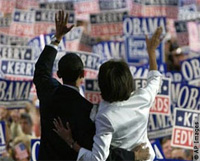 |
|
| U.S.
Government >
Elections |
|
Presidential Elections The United States Constitution stipulates that a presidential election is to be held once every fourth year. The process of electing a president and vice-president, however, begins long before election day. The nominating process within the political parties officially begins with the first state primaries and caucuses, which usually occur in the month of February of the election year. These primaries and caucuses choose slates of delegates (usually pledged to support particular candidates) to represent the state at the national party conventions. At the national party conventions, traditionally held in the summer, the delegates from the states cast votes to select the party's candidate for president. On election day -- the first Tuesday following the first Monday in November of an election year -- every citizen of legal age who has taken the steps necessary in his or her state to meet the voting requirements (such as registering to vote) has an opportunity to vote. However, the president is not formally chosen by direct popular vote. The constitution calls for a process of indirect popular election known as the electoral college. The Electoral College State and Local Government See also:
| |
| Texts are abridged from U.S. State Department IIP publications and
other U.S. government materials. |
|
| What kind of information
materials are available?
CD: These documents are available in fulltext format on the About the USA CD-ROM. Teachers: Request a copy for classroom use. L: Selected documents are available in German as well as other languages, including Arabic, Chinese, French, Spanish, Persian and Turkish. |
| DISCLAIMER Any reference obtained from this server to a specific commercial product, process, or service does not constitute or imply an endorsement by the United States Government of the product, process, or service, or its producer or provider. The views and opinions expressed in any referenced document do not necessarily state or reflect those of the United States Government. |
 U.S. Diplomatic Mission to Germany /Public Affairs/ Information Resource Centers Updated: March 10, 2009 |
